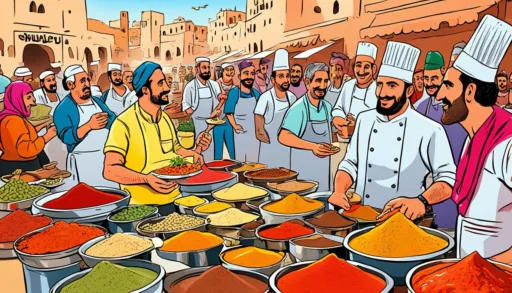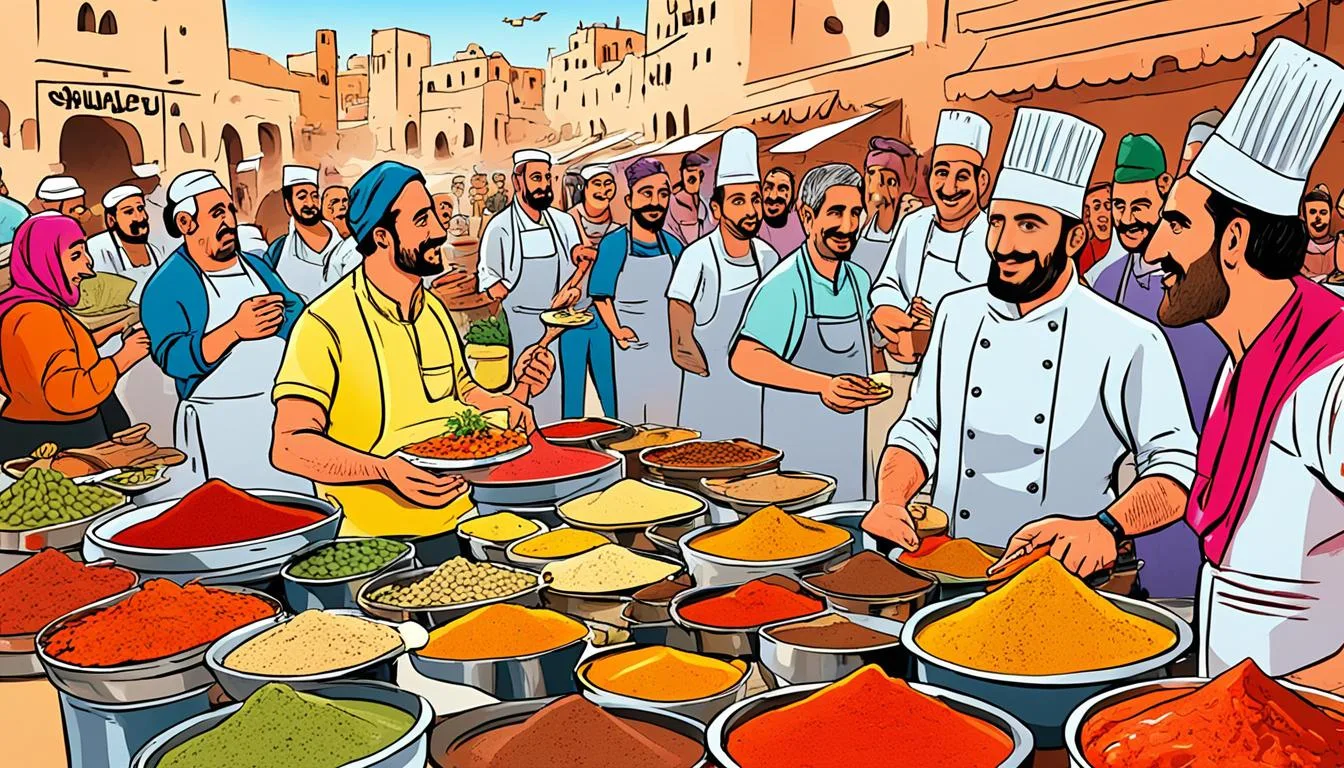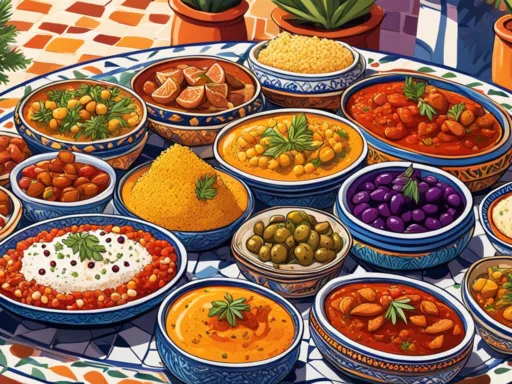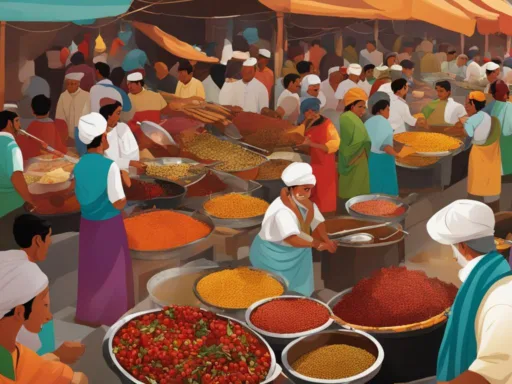Imagine a place where a single bite can transcend continents, threading the needle between the Mediterranean’s zest and the heartiness of the African continent. Libya, a land oft-overlooked in the global culinary scene, is home to an astonishing tradition of flavor—one where more than 90% of its dishes are a result of the fusion of North African, Mediterranean, Arab, and Berber influences. This melting pot has manifested in countless traditional Libyan recipes, forming a cornerstone of authentic Libyan cuisine that both intrigues and delights the palate.
In Libya, culinary finesse is not just about the food on the plate but an embodiment of cultural stories and historic journeys. Here, a family’s pride often simmers in a clay pot, sharing fragrant secrets from generations past. Exploring the myriad Libyan culinary discoveries offers a taste of this vibrant and lesser-known food culture that beckons food enthusiasts and cultural connoisseurs alike to dive into its delectable and diverse dishes.
Key Takeaways
- Libya’s rich culinary tradition is a crossroad of North African, Mediterranean, Arab, and Berber culinary practices.
- Traditional Libyan recipes are steeped in history and are reflective of the country’s vibrant mix of cultures.
- Authentic Libyan cuisine offers a unique and memorable gastronomic experience full of spices and flavors.
- Libyan dishes are more than just meals; they’re tales of communion, heritage, and the art of hospitality.
- Discovering the various aspects of Libya’s food culture can be a surprising adventure for the global food lover.
The Essence of Libyan Culinary Art
The aromatic world of Libyan cuisine is an olfactory and gustatory delight, deeply rooted in the sandy soils and the bustling markets of Libya. Known for its rich blend of flavors, Libyan dishes offer a feast for the senses, where each meal is an opportunity to experience the country’s long-standing food traditions and innovative Libyan cooking techniques.
The Influence of Mediterranean and African Flavors
The Libyan spice palette is a tapestry delicately woven with threads from the Mediterranean sea breeze and the earthy tones of the African continent. It’s here that the fusion of tangy, sweet, and savory notes come together through ingredients like olives, dates, and the ubiquitous Libyan spices and flavors such as mint, cumin, and cinnamon. These seasonings are pivotal in homemade Libyan dishes, immortalizing a flavor profile that is both bold and comforting.
Communal Dining: A Signature of Libyan Culture
In the communal dining traditions of Libya, families and friends gather around the table to share more than just food; they share stories, laughter, and camaraderie. Here, dining transcends beyond nourishment, reflecting the open arms of Libyan hospitality. From sharing a steaming bowl of couscous to passing around plates piled high with grilled lamb, the act of eating together strengthens bonds and underscores the significance of meals prepared with love.
Libya’s Culinary History: A Melting Pot of Civilizations
Libya’s appetite for diverse cuisine mirrors its storied past, with influences from the Phoenicians, Greeks, Romans, and Arabs. Each civilization that touched its shores left behind an indelible mark on Libyan cooking methods and flavors. This confluence has resulted in a rich culinary mosaic where ancient foodways meld seamlessly with modern tastes, forming a robust culinary identity unique to the Libyan nation.
The true essence of Libyan culinary art lies in its deep respect for the sanctity of its ingredients and recipes, many of which have been passed down through the generations. For those fortunate enough to sit down to a traditional Libyan meal, it is to partake in a heritage that triumphs both the simplicity of fresh catches from the Mediterranean and the bounty of the Saharan oasis. It’s an unforgettable journey of taste that continues to captivate the hearts and palates of all who visit this enchanting land.
Libyan Culinary Discoveries: A Taste of North Africa
Embark on an epicurean journey to the heart of North Africa with the rich and savory tastes of traditional Libyan recipes. From the bustling markets in the old quarters to tranquil homes in the oases, Libyan gastronomy offers a palate of flavors steeped in a history as old as the Sahara itself.
Couscous: The Country’s Beloved Staple
Couscous is more than just a dish; it’s a culinary institution in Libya, central to the nation’s identity. This versatile grain serves as a canvas for the rich tapestry of Libyan spices and flavors, often mixed with tender meats, robust vegetables, and the warmth of a communal pot, mirroring the sociable spirit that defines Libyan culture.
Stews and Soups: Comfort Foods of Libya
Libyans take pride in their stews and soups, with traditional Libyan recipes like the aromatic Bazin and heartwarming Shakshuka. Drawing on the country’s bountiful produce and generous use of spices, these dishes encapsulate the essence of Libyan hospitality, inviting all to gather and share in the comfort they provide.
The Aromatic Bounty: Libyan Spices and Flavors
As you continue exploring Libyan gastronomy, you’ll uncover an aromatic bounty that serves as the foundation of its cuisine. Cumin, coriander, cinnamon, and chili are just a few of the Libyan staples that contribute to the distinctive flavors which have been perfected over generations, ensuring each dish is as memorable as the last.
Sourcing Ingredients: The Bedrock of Libyan Cuisine
The flavorsome journey through authentic Libyan cuisine starts with a deep reverence for high-quality ingredients that form the essence of this rich gastronomic culture. Each ingredient used in Libyan food tells a story of tradition, environment, and an unwavering commitment to taste. Essential to creating the vibrant and robust dishes are the staple components such as couscous and lamb, each contributing a distinct texture and flavor that’s unique to the region’s palate.
The essence of Libyan spices and flavors lies in the masterful use of aromatic spices. Spices like cumin and paprika are not merely additions but foundational building blocks that transform a dish’s character. Nuts provide a crunch and nuttiness, which complement the succulent flavors of meats and fresh vegetables. As for herbs, the freshness of mint and the distinct aroma of coriander elevate the dishes, permeating them with scents that evoke the Libyan landscapes.
| Ingredient | Role in Libyan Cuisine | Common Dishes |
|---|---|---|
| Couscous | Base for many meals, absorbs the flavors of accompanying stews | Couscous with Lamb, Couscous Salad |
| Lamb | Primary meat, revered for its tenderness and taste | Mubatan, Grilled Lamb Skewers |
| Cumin | Key spice, adds earthiness and warmth | Bazin, Harira Soup |
| Paprika | Weaves in a sweet, smoky dimension | Lamb Tagine, Shakshuka |
| Mint | Refreshing herb for garnishes and flavoring | Tea, Couscous Salads |
| Coriander | Bright and citrusy notes, used both fresh and dried | Stews, Mubatan filling |
Freshly baked flatbread accompanies nearly every meal, serving as a utensil for scooping and a porous vessel to savor the last remnants of a delectable stew. It’s these simple yet high-quality ingredients, when combined, that capture the true heart of Libyan spices and flavors, inviting dedicated culinarians and everyday epicureans alike to indulge in the rich tapestry of authentic Libyan cuisine.
Libyan Cooking Techniques: From Tagine to Grill
Libyan cuisine celebrates a rich array of cooking techniques that have been perfected over centuries, each adding its distinctive flavor to traditional Libyan recipes. A journey into the heart of homemade Libyan dishes offers a delicious glimpse into the country’s culture, from the delicate blend of spices in a tagine to the smoky tang imparted by an open flame grill.
Tagine: Slow-Cooking at Its Finest
Tagine cooking is fundamental to Libyan culinary art, with its roots deeply entrenched in North African traditions. The conical shape of the tagine pot is designed to return all condensation to the bottom, ensuring that the slow-cooked meal remains tender and flavorful. This traditional Libyan recipe commonly features mixtures of lamb, vegetables, and a rich medley of spices like saffron, ginger, and turmeric, slowly simmered to perfection.
Open Flame Grilling: A Taste of the Libyan Outdoors
When it comes to experiencing the robust essence of Libyan cooking techniques, nothing quite compares to the open flame grilling popular across Libya’s lively streets and tranquil backyards. Grilled dishes, particularly kebabs, are a staple in Libyan cuisine. Meats marinated in an assortment of herbs and spices are seared over hot coals, creating a smoky crust that encapsulates the juicy, flavorful interior.
Baking Traditions: Breads and Pastries
The scents of freshly baked bread and pastries are a hallmark of Libyan households. Breads such as the staple Khobz are not just nourishment but a symbol of Libyan hospitality. Delicate pastries, including the sweet Ma’amoul, filled with dates or nuts, are baked during festive times and offer a delectable insight into homemade Libyan dishes.
Mastering Libyan cooking techniques allows for a deeper connection to the gastronomic history of the region, ensuring that the essence of Libyan cuisine continues to flourish with each dish prepared. Whether through the slow infusion of flavors in a tagine or the rustic simplicity of grilling, each method contributes to a rich culinary landscape.
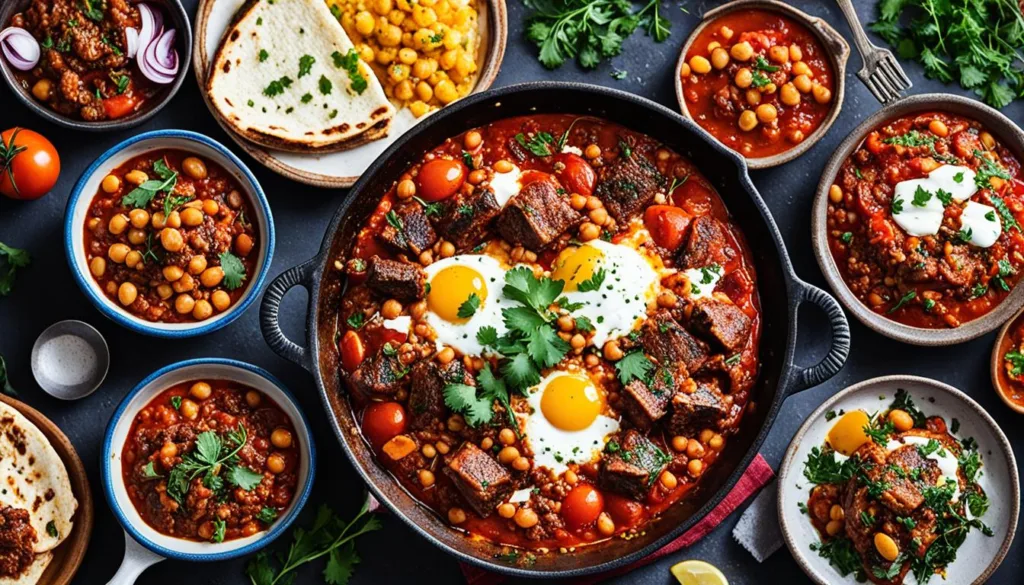
A Tour of Flavor: Signature Libyan Dishes
Taking a deep dive into the rich tapestry of Libyan food allows us to discover a culinary landscape where the traditional Libyan recipes tell stories of the land’s generous offerings. The nation’s proximity to the Mediterranean Sea marries perfectly with its robust inland ingredients, crafting a menu that highlights its authentic Libyan cuisine at its best.
A Blend of Sea and Land: Libyan Kebabs and Seafood
The Libyan coast is not just picturesque but also serves as a bountiful source of seafood, which, when combined with the country’s love for grilled meats, produces delectable kebabs that capture the essence of the Mediterranean. Each skewer is lovingly seasoned with a blend of local spices, demonstrating the culinary finesse with which Libyans approach both land and sea harvests.
Bazeen: A Hearty and Rustic Delight
Beyond the grills, Libya’s heartland offers the equally beloved Bazeen, an iconic dish made from barley or wheat. This fundamental staple holds a special place in Libyan hearts, representing camaraderie and the nation’s rural strength. It’s a cultural touchstone, embraced in town gatherings and family meals alike for its simplicity and ability to satisfy.
Libyan Pasta Variations: The Italian Influence
The Italian imprint remains visible through Libyan pasta creations, where dishes like Maakarouna are personalized with local flavors, marrying the Mediterranean’s past and present. These pasta dishes have become an integral part of Libyan dining, showcasing the adaptability and evolvement of the country’s culinary landscape over time.
| Dish | Main Ingredients | Typical Occasion |
|---|---|---|
| Libyan Kebabs | Lamb, Beef, Spices | Festivals and Family Gatherings |
| Seafood Delights | Fish, Shrimp, Spices | Coastal Celebrations |
| Bazeen | Barley, Lamb, Tomato Sauce | Communal and Traditional Events |
| Maakarouna | Pasta, Tomato Sauce, Local Spices | Everyday Meals |
In Libyan kitchens, the heart beats to a rhythm set by the harmony of flavors. A cuisine that extends a welcoming hand, celebrating its traditions, while also sharing its adaptability and global influence. Libyan dishes, each with a story, invite you not just to taste but to participate in a centuries-old legacy of preparing and enjoying food that stands symbolic of the Libyan way of life.
Authentic Libyan Recipes for Home Chefs
Exploring traditional Libyan recipes allows home chefs to experience the rich tapestry of flavors that make homemade Libyan dishes so distinct and beloved. With an array of Libyan cooking techniques at your fingertips, the culinary journey of North Africa is beckoning from the comfort of your own kitchen.
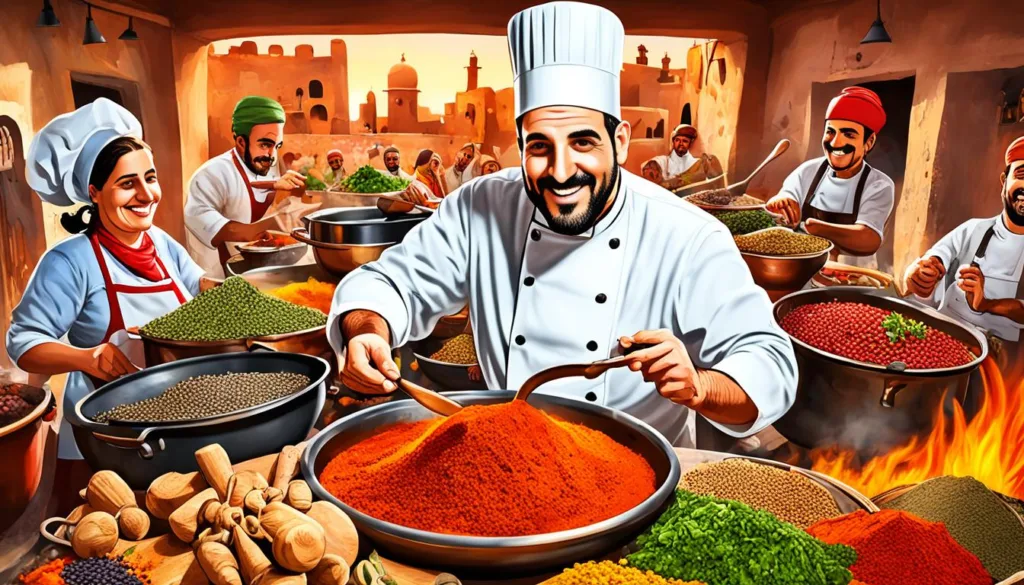
- Couscous with Lamb: A national favorite that is the epitome of Libyan comfort food. The fragrant spices meld with the tender meat to create a heartwarming dish.
- Bazin: Immerse yourself in the making of this rich tomato-based stew, an essential in the Libyan culinary lineup.
- Shakshuka: A versatile choice for any meal of the day, shakshuka is a satisfying stew of eggs poached in a sauce of tomatoes, chili peppers, and spices.
- Mbakbaka: Easy to make yet packed with flavor, this traditional pasta dish is a delightful introduction to the Libyan take on pasta.
Each of these dishes provides a unique opportunity to practice the culinary arts of Libya. Whether you’re gently simmering a pot of Bazin or spice-infusing your lamb for couscous, the aromas and tastes will transport you straight to the heart of Libya’s cultural heritage. Embrace the spices, embrace the techniques, and most importantly, embrace the joy of creating and sharing these delightful meals.
Libya’s Street Food Scene: A Discovery of Tastes
Wandering through the bustling streets of Libya, the air is rich with the aromas of sizzling meats and sweet confections. This immersive tapestry of scents and sounds is the heartbeat of Libyan street cuisines—an essential part of exploring Libyan gastronomy. From Tripoli to Benghazi, street vendors offer an authentic gateway to understanding true Libyan food.
Savoring Savory Street Bites
Stroll down any Libyan market, and you’ll find a variety of savory street foods that are synonymous with daily life. The allure of freshly grilled skewers draws locals and travelers alike, while the ubiquitous shakshuka—a blend of eggs, tomatoes, and spices served in a cast-iron pan—beckons the hungry passerby. These bites are not just nourishment; they represent a way of life, exuding the warmth and generosity inherent to Libyan street food culture.
Street Sweets: Indulging in Libyan Desserts
The sweet component of Libyan street cuisine is as enticing as the savory. Treats like Luqaimat—deep-fried dough balls drizzled with date syrup—and the ever-popular Baklava, with its crisp layers of filo and honeyed nuts, satisfy the sweetest of tooths. These confections, rooted in Libyan heritage yet influenced by the broader Middle Eastern dessert palette, offer a delectable end to any street food feast.
Libyan Spices and Flavors: Crafting Distinctive Tastes
The culinary tapestry of Libya is woven with an array of Libyan spices and flavors that distinguish it from its global counterparts. Each dish is a testament to the country’s rich history and the influence of the Mediterranean, an intricate dance of taste and tradition that is both comforting and exotic.
Harissa: The Fiery Staple of Libyan Cuisine
Central to the bold taste profile of authentic Libyan cuisine is Harissa—a fiery chilli condiment whose vibrant red hue is only a hint at the explosive flavor it imparts. This spice blend, which often includes garlic, coriander, cumin, and olive oil, encapsulates the essence of the nation’s love for depth and heat in its culinary creations.
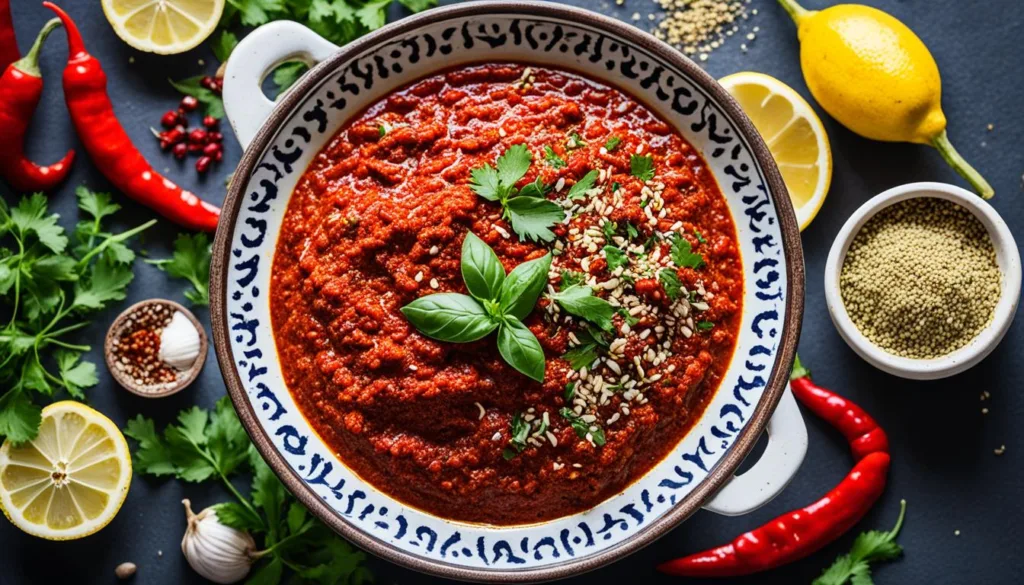
Spice Blends: The Secret to Libyan Cooking
It is in the artful combination of spices where the magic of Libyan cooking truly happens. Cumin, paprika, cinnamon, and other regional spices are carefully married into blends that breathe life into every recipe—be it for a robust meat stew or a simple lentil soup. The mastery of these blends turns every meal into an aromatic voyage, inviting one’s senses to a feast as rich and layered as Libya’s vibrant culture itself.
Homemade Libyan Dishes: Sharing Meals and Memories
Delving into the heart of Libyan culinary art, the experience of preparing and indulging in homemade Libyan dishes is a testament to familial bonds and communal solidarity. The act of cooking traditional Libyan recipes is more than a routine; it’s an art form that unites generations, preserves rich culture, and builds lasting memories around the dining table.
Within Libyan households, the kitchen serves as a stage where the drama of life and the pleasure of togetherness intermingle. Whether it’s kneading dough for bread or meticulously seasoning meats and vegetables, the process is as significant as the meal itself. Traditional Libyan recipes like Couscous, Bazin, or Harissa transcend their ingredients, representing a narrative thread in the fabric of Libya’s priceless heritage.
These comforting homemade Libyan dishes convey stories of ancestry and identity; they are culinary heirlooms that pass from one generation to another. With each shared dish, the essence of Libyan family values, customs, and the very spirit of sharing is celebrated; for it is in these moments that individual memories merge into collective history.
| Libyan Dish | Key Ingredients | Associated Memories/Customs |
|---|---|---|
| Couscous | Semolina, Lamb, Vegetables, Spices | Gatherings and Festive Celebrations |
| Bazin | Barley Flour, Tomato Sauce, Meat or Fish | Family Weekends, Communal Eating |
| Shakshuka | Eggs, Tomato Sauce, Onions, Chili Peppers | Breakfasts and Conversations |
Every spoonful from these dishes resonates with the warmth of shared experiences and affectionately nurtured bonds. It is not just about taste, but the joy found in the simple gestures of passing down a recipe, tasting a slice of history, and sitting side by side at a table laden with the richness of Libya’s culinary traditions. This is the living, breathing legacy of Libyan culinary art—served up plate by cherished plate.
Exploring Libyan Gastronomy Through Regional Specialties
Embarking on a journey into the heart of exploring Libyan gastronomy reveals a rich mosaic of regional specialties, each with its own distinctive character and story. Delight in the coastal catches of Tripoli, the bustling market life of Benghazi, and the desert-surrounded cuisine of Sabha. Let’s unveil the culinary treasures that these regions have to offer.
The Coastal Offerings of Tripoli
With the Mediterranean Sea lapping at its shores, Tripoli is a treasure trove of seafood delights, weaving the freshness of the ocean into traditional Libyan recipes. The famed Couscous Royale, brimming with a variety of sea bounty, represents Tripoli’s generous spirit and its culinary prowess.
Benghazi’s Market Freshness
Benghazi’s culinary art is a direct reflection of its vibrant markets, overflowing with locally-sourced fruits and vegetables that infuse freshness into every dish. The city’s version of shakshuka, with its plump tomatoes and fresh herbs, is a testament to the market’s influence on its traditional fare.
The Desert Delicacies of Sabha
Contrasting the coastal and urban offerings, Sabha’s location in the heart of the desert shapes a unique food culture, marked by hearty, rustic dishes that embody the essence of Libyan culinary art. This region’s adaptation to its harsh environment is showcased through its rich, comforting flavors.
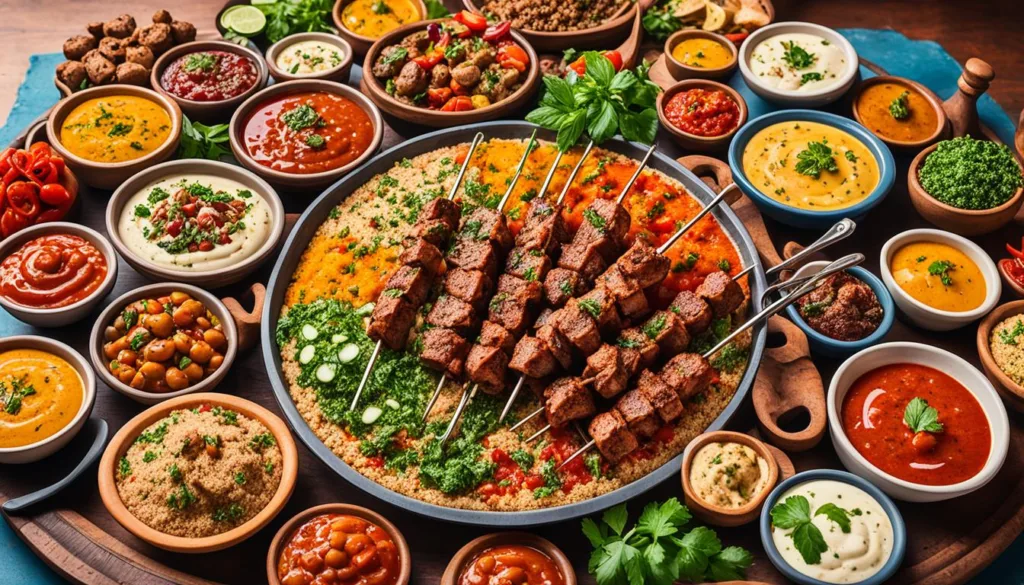
| Region | Specialty | Description |
|---|---|---|
| Tripoli | Couscous Royale | A sumptuous blend of seafood served over couscous, seasoned with a melody of Mediterranean spices. |
| Benghazi | Market Fresh Shakshuka | An aromatic tomato and egg dish enriched by the freshest produce from the local markets. |
| Sabha | Desert Lamb Tagine | A savory, slow-cooked lamb stew that incorporates desert herbs and spices, reflecting the robustness of desert cuisine. |
Libyan Dining Etiquette: A Guide for Travelers
Exploring Libyan gastronomy isn’t complete without a deep appreciation for its food culture, especially when it comes to dining etiquette. For those embarking on Libyan culinary discoveries, a grasp of traditional dining customs can enrich the overall travel experience. Delving into these customs requires not just a taste for adventure but also a respect for the country’s esteemed traditions.
Understanding Communal Dining
Communal dining is the heartbeat of Libyan food culture, bringing families and friends together over a shared meal. This practice exemplifies the Libyan spirit of community and hospitality, where a group gathers around a central dish, often a large platter of couscous or stew, creating a bond built upon shared flavors and experiences. It’s a cherished act that underscores the value of togetherness in Libyan society.
Table Manners and Gestures
Among the many gestures of respect and courtesy in Libyan dining, using your hands to eat is both common and expected, especially when it comes to bread and other staples. However, it’s the right hand that is traditionally used for eating, as the left is considered impolite. Meal pacing is another crucial aspect. Eating too fast or too slow is not recommended, as it’s all about synchrony with the group. Observing and emulating the actions of the host or other diners is a wise strategy for those new to Libyan dining etiquette.
Showcasing a respectful participation in mealtime rituals, including expressing gratitude for the meal, helps bridge cultural gaps and foster a genuine appreciation for the nuances of Libyan life. By embracing these dining etiquettes, travelers can fully immerse themselves in the wealth of culinary experiences and social intricacies that Libya has to offer.
Conclusion
Embarking on a journey through Libya and its exquisite palate of flavors provides a gateway to understanding the nation’s soul. Libyan food culture, steeped in the diverse influences of the Mediterranean, Africa, and the Middle East, is a canvas painted with the hues of its rich history and culinary customs. It is through sharing a plate of couscous or savoring the spice-laden aroma of a tagine that one truly experiences the essence of authentic Libyan cuisine.
Experiencing Libya Through Its Food
Beyond mere nourishment, Libyan culinary heritage serves as an intimate portrayal of its people’s lifestyle and traditions. It forges connections in communal dining settings and communicates a legacy of hospitality. From the bustling markets of Benghazi to the serene desertscape of Sabha, every bite narrates a chapter of Libya’s gastronomic story, inviting both worldwide travelers and culinary enthusiasts to embrace and explore the myriad flavors of this captivating North African land.
The Evolution of Libyan Cuisine
The tenacity of Libyan cuisine, with its ability to embrace change while honoring its foundation, is nothing short of remarkable. As global palates shift and the world becomes more interconnected, Libyan dishes continue to evolve, finding the perfect equilibrium between modernity and tradition. This fervent preservation and simultaneous exploration of culinary avenues ensure that Libyan food culture remains a vibrant and evolving journey, one that promises to delight and educate for generations to come.
FAQ
What are some traditional Libyan recipes?
Some traditional Libyan recipes include Couscous with lamb, Bazeen (a unique Libyan dish served with a tomato sauce and sometimes boiled eggs or potatoes), Shakshuka (eggs poached in a spicy tomato sauce), and Mubatan (stuffed potato slices). Each dish represents the fusion of flavors and cooking traditions that define Libyan cuisine.
What defines authentic Libyan cuisine?
Authentic Libyan cuisine is characterized by its embrace of Mediterranean and African flavors, extensive use of aromatic spices like cumin, paprika, and mint, and a blend of cooking techniques from slow-cooked stews in tagines to grilled meats and baked breads. The ingredients are fresh, and communal dining is a significant aspect of the food culture, reflecting Libyan hospitality.
What are some common Libyan spices and flavors?
Libyan dishes are typically seasoned with a range of spices that include cumin, coriander, cinnamon, paprika, and chili. Harissa, a spicy chili paste, is a staple condiment in Libyan cuisine, used to add heat and depth to many dishes. These spices create the savory and aromatic profiles for which Libyan food is known.
Can you explain some Libyan cooking techniques?
Libyan cooking techniques vary from baking to grilling to stewing. Tagines are frequently used for slow-cooking dishes, creating tender, flavor-infused meats and vegetables. Open-flame grilling is a customary way to prepare kebabs, while baking is an essential technique for making traditional breads like Khobz or sweet pastries such as Ma’amoul.
What kind of street food can be found in Libya?
Libya’s street food scene offers a wealth of savory bites such as shakshuka and grilled meat skewers, along with sweet treats like Baklava and Luqaimat – deep-fried dough balls soaked in syrup. This range of street foods provides a taste of Libyan everyday culinary delights.
How do homemade Libyan dishes play a role in the culture?
Homemade Libyan dishes are central to the cultural practice of sharing meals and memories with family and friends. They showcase the country’s traditions and customs, with recipes passed down through generations that speak to the heritage and identity of Libyan communities.
What are some regional specialties in Libyan gastronomy?
Libyan gastronomy varies by region, each with its specialties reflecting local ingredients and histories. In Tripoli, you can enjoy Couscous Royale and an array of seafood dishes. Benghazi is known for fresh market produce influencing dishes like Shakshuka, while Sabha’s desert environment offers rustic meals that speak to its unique adaptation to the surroundings.
What should travelers know about Libyan dining etiquette?
Travelers should be aware that communal dining is a significant part of the dining experience in Libya, and it’s common to eat with one’s hands, specifically the right hand. Guests are expected to take their time enjoying the meal and to partake in the tradition of sharing. Understanding these dining customs can enhance the cultural experience for visitors.
What are the key features of a Libyan culinary exploration?
Exploring Libyan cuisine reveals a culinary landscape rich with diversity and tradition. Key features include the harmonious use of spices, a strong sense of communal dining and hospitality, and the seamless blend of various cultural influences that have shaped Libyan food over centuries.
